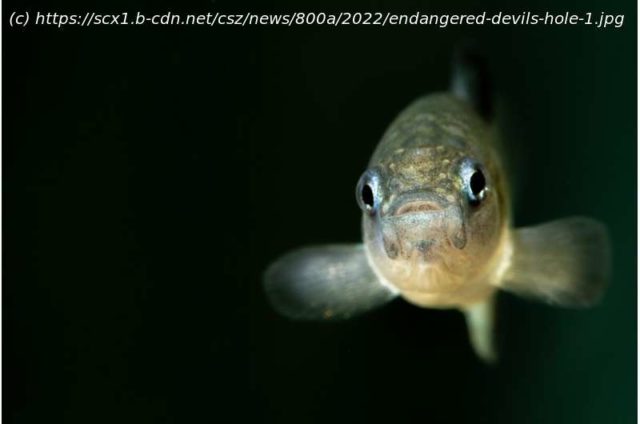As its name implies, the Devil’s Hole pupfish lives in a truly hellish environment.
As its name implies, the Devil’s Hole pupfish lives in a truly hellish environment.
Confined to a single deep limestone cave in Nevada’s Mojave Desert, 263 of them live in water that hovers around 93 degrees Fahrenheit year-round, with food resources so scarce that they are always on the edge of starvation, and with oxygen levels so low that most other fish would die immediately. The pupfish, Cyprinodon diabolis, live in the smallest habitat of any known vertebrate.
New research now documents the extreme effect that these harsh and isolated conditions have had on this fish’s genetic diversity.
In a paper published this week in the journal Proceedings of the Royal Society B, University of California, Berkeley, biologists report the first complete genome sequences of eight pupfish species from the American Southwest—30 individuals in all, including eight Devils Hole pupfish. Astoundingly, the Devils Hole pupfish is so inbred that 58% of the genomes of these eight individuals are identical, on average.
« High levels of inbreeding are associated with a higher risk of extinction, and the inbreeding in the Devils Hole pupfish is equal to or more severe than levels reported so far in other isolated natural populations, such as the Isle Royale wolves in Michigan, mountain gorillas in Africa and Indian tigers, » said lead researcher Christopher Martin, UC Berkeley associate professor of integrative biology and curator of ichthyology in the campus’s Museum of Vertebrate Zoology. « Although we were not able to directly measure fitness, the increased inbreeding in these pupfish likely results in a substantial reduction in fitness. »
Other pupfish species are also inbred, the researchers found, but only between 10% and 30% of their genomes are identical.
Graduate student David Tian, lead author of the study, said that the level of inbreeding in the Devils Hole pupfish is equivalent to what would happen if four to five generations of siblings mated with one another. This tends to burn in or fix, rather than weed out, harmful mutations, potentially dooming a population to extinction by mutational meltdown. The Devils Hole pupfish species is currently doing well in the wild and in captive or « refuge » populations, but such low genetic diversity could spell trouble as the climate changes and human impacts become greater.
In the face of these potential threats, the new genome sequences will help scientists and conservationists assess the health of native pupfish populations and potentially intervene in refuge populations to increase the genetic diversity of these species—the Devils Hole pupfish, in particular.
« With this new genomic data, there’s a lot of potential to look not just at genetic diversity and how these species are related to each other phylogenetically, but also look at inbreeding and mutation load to get an idea of what their current status is, how evolutionary history may have influenced their current genetic variation, and think about where the population is going and what we should do, if anything, to preserve these species, » Tian said.






